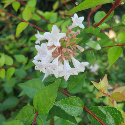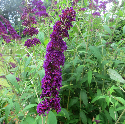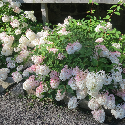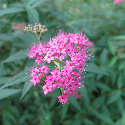Abelia – Your grandmother grew glossy abelia, and it was a small leafed green plant with small bell shaped white flowers. Today, there are so many better varieties with a range of leaf colors and even some new flower colors. ‘Kaleidoscope’ is a smaller form which grows to three feet tall and about 3-4 feet wide. New growth appears with lime-green centers and bright yellow edges. When summer arrives, the yellow matures to orange and the variegation doesn’t fade. In fall and winter the foliage color deepens to shades of orange and fiery red. It blooms with small white blooms from frost to frost. ‘Twist of Lime’ is another low grower with white, yellow and green foliage and pale pink blooms, while ‘Bronze Anniversary’ is a variegated larger abelia getting about 48 inches tall. Some dark pink bloomers include the older variety ‘Edward Goucher’ and the new dwarf ‘Pinky Bells’ which only grows 24-36 inches tall and has pink blooms all season. The newest variety ‘Sunny Anniversary’ has green foliage but a yellow and pink bloom that grows up to 4 feet tall. In Arkansas, most abelian are evergreen, but can shed some leaves in the coldest years. They thrive in full sun to partial shade and are quite attractive to bees and butterflies.
Contact
Randy Forst
Extension Educator - Consumer Horticulture
Phone: (501) 671-2245
Email: rforst@uada.edu
University of Arkansas System
Division of Agriculture
Cooperative Extension Service
2301 S. University Avenue
Little Rock, AR 72204
Ornamental Shrubs in Arkansas Landscape
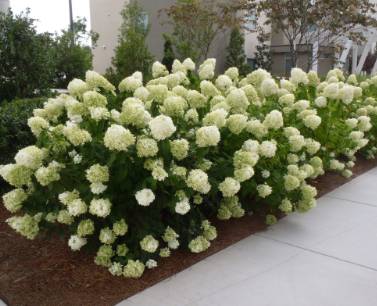
A shrub may be defined as a woody plant of relatively low height (< 20 ft) and having several stems arising from the base. Although the distinction may not be black & white in all situations, a shrub is most often distinguished from a tree by its multiple stems and shorter height.
In addition to a variation in plant height, shrubs can be grouped according to characteristics such as leaf retention and flowering.
Deciduous or evergreen shrubs
For leaf retention, plants may be categorized as either deciduous (lose leaves every fall) or evergreen (leaves retained during the winter). Broadleaf evergreen shrubs such as hollies, Indian hawthorn, glossy abelia, thorny Elaeagnus, gardenia, azalea, heavenly bamboo, and Chinese fringeflower are frequently used in Arkansas landscapes.
Flowering, fruiting, and fall color
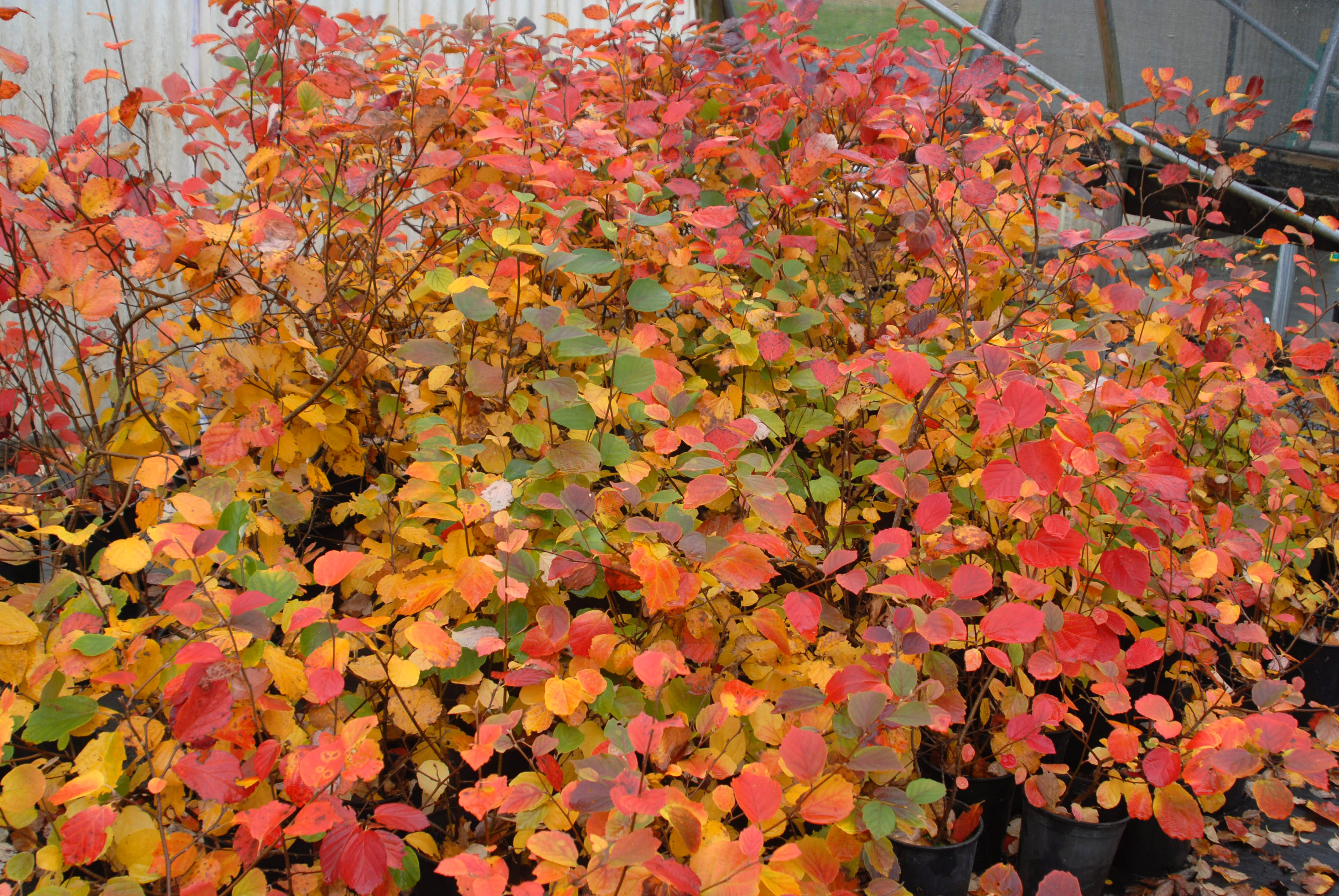
For flowering, plants may be categorized as either monoecious (mow-knee-shuss) [if both male and female flowers appear on the same plant] or dioecious (di-ee-shuss) [if all of the flowers on a plant are male, or female]. Knowing that a shrub is dioecious is important especially when we want fruits (female plants). On shrubs such as holly (Ilex) and Aucuba you want mostly female plants so you can enjoy the beautiful fruits.
Ornamental shrubs are a key component of any landscape as they can contribute flowers, fruits, and fall color to the garden design. Ornamental shrubs may also serve to attract wildlife to your garden. With such a large array in plant sizes and textures, ornamental shrubs are a key component of any landscape. A sustainable landscape will match the appropriate plant to the specific site.
Summer Flowering Shrubs
We want our landscapes to have color in every season. There are many good flowering shrubs to choose from that can take the heat of an Arkansas summer.
Althea or Rose of Sharon – This member of the hibiscus family has made a big comeback in recent years. The plants can be pruned as much or as little as you like before growth begins, since they bloom on the new growth. Mature height on a standard variety can be 8-15 feet depending on variety, but they can be pruned more if needed. Flower color can range from white, pink, purple and apricot, with doubles and singles, and bi-colors thrown in. New varieties do not set seeds, so they don’t have to be deadheaded and will continue to bloom all summer. ‘Aphrodite’ – is a pink flowering form with a dark red center. ‘Pink Chiffon’ has large lacy double pink blooms; ‘Blue Satin’ has a large deep blue single bloom. ‘Lil Kim’ is a dwarf form that only gets 3 feet tall with white flowers and a deep red throat. They thrive in full sun to partial shade, and will reward you with months of blooms if given enough light. They do best with moderate amounts of water and fertilizer—but don’t overdo it.
Buddleia – Butterfly bush is a long blooming plant with outstanding blooms in purple, pink, white or red. The new dwarf plants include Lo and Behold ‘Blue Chip’, Lavender Chip and White Chip. These plants are deciduous in colder winters but fit easily into any sun landscape. Older varieties set seeds and started becoming a bit invasive in some states. New varieties don’t set seeds, so bloom continuously. Larger varieties include: ‘Miss Molly’ with deep red blooms, ‘Black Knight’ with dark purple flowers, ‘Asian Moon’ with lavender blooms and ‘Peach Cobbler’ with peachy, pink blooms. Full sun provides more flowers. Prune them hard in late February, because they bloom on the new growth. If you don’t prune, they tend to get woody and less productive. Choose plants that will fit the situation. From dwarf to standards, they thrive in sunny locations.
Clethra or summersweet is a great native shrub for full sun to partial shade. From standards to dwarfs, this deciduous shrub begins to bloom in late June or July with fragrant pink or white blooms. Also called sweet pepperbush because of the pepper like seed pods which persist all winter, it is a low maintenance shrub for the summer landscape. ‘Ruby Spice’ is a pink flowering form growing to 8 feet tall. Two good dwarf forms ‘Sixteen Candles’ and ‘Hummingbird’ are great bloomers on a compact plant.
Crape myrtles come in groundcover to tree forms, so choose the size you need. They thrive in hot weather and bloom all summer. Groundcover forms include : ‘Rosy Carpet’ and ‘Orchid Cascade’ growing no taller than two feet. Dwarf forms include Ozark Spring and Dwarf White which get no taller than 5 feet. The new Black Diamond series with dark almost black foliage grow up to 10-12 feet tall and then the standard Natchez and Biloxi can get up to 30 feet tall. By choosing a plant that at maturity will fit your landscape needs, you can avoid ‘crape murder’!
Visit our crape myrtle database
Hydrangeas are in a class by themselves. While most people plant the big leafed varieties

The Hydrangea paniculata is also making a strong showing in the garden. These hydrangeas
bloom on the new growth and will take more sun. They also don’t wilt nearly as much
as the big leafed forms in hot, dry days. PeeGee or panicle hydrangeas as they are
commonly called usually have large white blooms which can fade to shades of pink.
‘Limelight’ has pale green to white flowers which fade to white, while ‘Pink Diamond’
has pink and white blooms. Other new varieties to try include ‘White Diamonds’, ‘Chantilly
Lace’ and the new dwarf ‘Pinky Winky’. Another hydrangea that blooms on new growth,
so is not bothered by winter is the Annabelle or smooth hydrangeas
(Hydrangea arborescens). From the old fashioned Annabelle with large white blooms
to the newer Invincibelle, Invincibelle Spirit, and Invinciball.
Visit our hydrangeas page for more information.
Summer blooming spirea are great additions to full sun to partial shade landscapes. Much more compact than their spring blooming cousins, the bridalwreath spirea, the summer spireas bloom as long as they are putting on new growth. ‘Anthony Waterer’, ‘Little Princess’, ‘Lime Mound’ and ‘Gold Flame’ have been around for many years. Newer introductions include ‘Magic Carpet’, ‘Double Play’ and ‘Neon Flash’. Deadhead the spent blooms and they will continue to bloom off and on all summer. Pest free and drought tolerant, once established, they are easy to grow, but they are deciduous and not the most attractive in the winter, so have some evergreens nearby for winter interest too.
